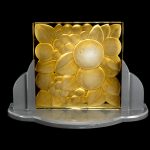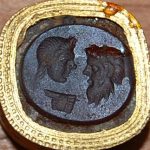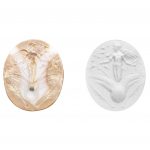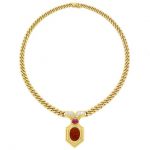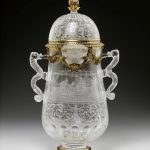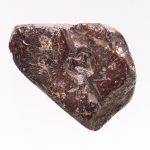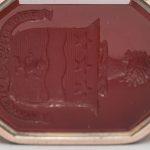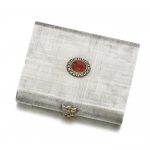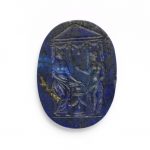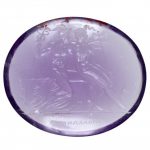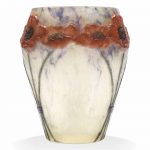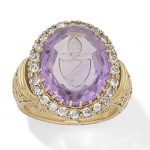Intaglios are the engravings on a gemstone, hardstone or glass. The are the reverse of a cameo. Intaglios are often used for jewellery and seals.
The engraving of gemstones was a major luxury art form in the Ancient world, and an important one in some later periods. Strictly speaking, engraving means carving in intaglio (with the design cut into the flat background of the stone), but relief carvings (with the design projecting out of the background as in nearly all cameos) are also covered by the term. This article uses cameo in its strict sense, to denote a carving exploiting layers of differently coloured stone. The activity is also called gem carving and the artists gem-cutters. References to antique gems and intaglios in a jewellery context will almost always mean carved gems; when referring to monumental sculpture, counter-relief, meaning the same as intaglio, is more likely to be used. Vessels like the Cup of the Ptolemies and heads or figures carved in the round are also known as hardstone carvings. Reference: Wikipedia
A rare Lalique intaglio-moulded yellow and frosted glass panel with fruit and leaves for the Oviatt Building los angeles UNSIGNED, CIRCA 1930 James Oviatt met Rene Lalique at the 1925 Paris Exposition and gave him a commission to create architectural panels for the Oviatt Building in Los Angeles, the first Art Deco style building in that city; with painted hardwood display stand 36cm square
Sold for £2,250 inc. premium at Bonhams in 2018
Brown glass paste intaglio: profile heads of Pan (?) and a youth, facing each other. Classical World
Reference: © The Trustees of the British Museum
A ROMAN SARDOYNX INTAGLIO WITH EROS ON A LOTUS FLOWER CIRCA 1ST CENTURY B.C. 20 mm. long max. Provenance Pavel Nikolaievich Demidoff (1798-1840), St. Petersburg and San Donato. G. Sangiorgi collection (1886-1965), Rome. Private collection, Monaco, 1970s; thence by descent.
Sold for GBP6,875 at Christies in 2017
Gold, Diamond, Cabochon Ruby and Hardstone Intaglio Necklace, Bulgari 18 kt., the oval link chain suspending a fancy-shaped pendant centering one oval hardstone intaglio depicting a warrior, within a stepped shield-shaped frame, topped by one oval cabochon ruby and 12 baguette and tapered baguette diamonds approximately 1.05 cts., pendant signed Bulgari, Warrior, II Cent. A.D., no. BD 2445, chain signed Bulgari, approximately 52.7 dwts. Length 15 1/8 inches.
Diamonds: F-G-VS. Ruby: medium deep pinkish-red, moderately included, slightly visible to eye, translucent, good polish. Hardstone: brick red and blackish mottling, opaque, several light scratches, minor hairline crack by feet, dull luster. Good condition. Normal wear, minor scratches to gold. Pendant 1 11/16 x 7/8 inches. Chain width 1/4 inch.
Sold for $8,750 (includes buyer’s premium) at Doyle New York in 2018
This spectacular rock-crystal vase from the collection of Cardinal Richelieu (1585-1642) entered the collection of Louis XIV (1638-1715) between 1681 and 1684. The stone, cut in the late Middle Ages, was engraved with decorative scenes in Milan in the 16th century. The mount was executed in two periods: in Milan in the 16th century and in France in the 17th century.
This is one of the oldest hard-stone vases with engraved decorative scenes. The belly features two framed scenes: on one side, Judith and Holofernes; on the other, Susannah and the Elders. The collection built up by Frédéric Spitzer in the 19th century included a rock-crystal intaglio depicting Judith and Holofernes by the engraver Giulio Taverna (mid-16th century), which bears a resemblance to the scene depicted on the vase. The intaglio and the vase are not necessarily by the same artist but may derive from the same bronze plate. The rest of the decoration is very similar to that of the ewer MR 281 and features a female term on one side and a male term on the other, both depicted between double branches of foliage ending in a winged term or a grotesque bird. On the lid, the theme of a term placed between two branches is repeated three times. The scenes are dotted with seeds and pea pods. The dragon-shaped handles were also recut in the 16th century. The two spouts sculpted with a bearded mask were added at a later date and may have come from another object.
Reference:The Louvre
Steatite block with intaglio motifs Period:Late Minoan III Date:ca. 1400–1200 B.C.
Stone mold used for making intaglio motifs on gold or glass.
Reference: The Metropolitan Museum of Art
Carnelian intaglio seal with John Oxley family’s coat of arms
This seal is a wonderful example of changes in jewellery, sparked by new technologies during the Georgian period; it also gives a glimpse into the lives of colonial Australians. The style of the seal is consistent with antique Georgian English carnelian intaglio seals produced in the 19th century. Made by converting old fob-watches, these seals usually contained very general crests rather than detailed crests specific to one distinct branch of a family. Developments in technology allowed for smaller and more proficient fob-watches, superseding previous models and making them redundant. Rather than disposing of these often ornate and precious older fob-watches, many were converted into seals. These were widely used to sign official documents, and were worn in much the same way as a fob-watch.
Reference: Museum of Applied Art and Sciences
Roman black and white banded onyx intaglio, oval shape with bevelled edge. Swan swimming to the left on rippling water. Provenance By date unknown: Burton Y. Berry Collection; gift of Burton Y. Berry to MFA, November 8, 1972 Credit Line Gift of Burton Y. Berry
Reference: Museum of Fine Arts Boston
Carnelian vanity case, Mario Buccellati The rectangular case of brushed finish, set with an oval carnelian intaglio depicting a dog within an acanthus leaf border, to a hinged clasp, opening to reveal a lidded powder compartment, sliding lipstick holder and mirror, measuring approximately 76 x 62 x 17mm, signed M.Buccellati, total gross weight approximately 197 grams.
Sold for 7,500 GBP at Sothebys in 2018
Intaglio, lapis lazuli, a Libation Scene, Italy, 16th century
This intaglio of Lapis Lazuli, depicts a Libation scene. A ‘Libation’ is the ritual of pouring a drink or liquid as an offer to a god in a ceremonial setting. Lapis Lazuli is a granular crystalline rock composed essentially of lazurite and calcite. An intaglio is refers to the technique of creating a design that is sunken into the surface, by carving or incising.
Reference: © Victoria and Albert Museum
Amethyst Intaglio of Hermes and Herse
The Greek god Hermes, identified by his “caduceus” (staff) and winged helmet, is seated next to Herse, the beautiful daughter of King Cecrops of Athens. Although dating from the 18th century, this intaglio is inscribed in Greek with the name “Appollonides,” an ancient gem engraver cited in Pliny’s “Natural History.”
Reference: The Walter Art Museum
